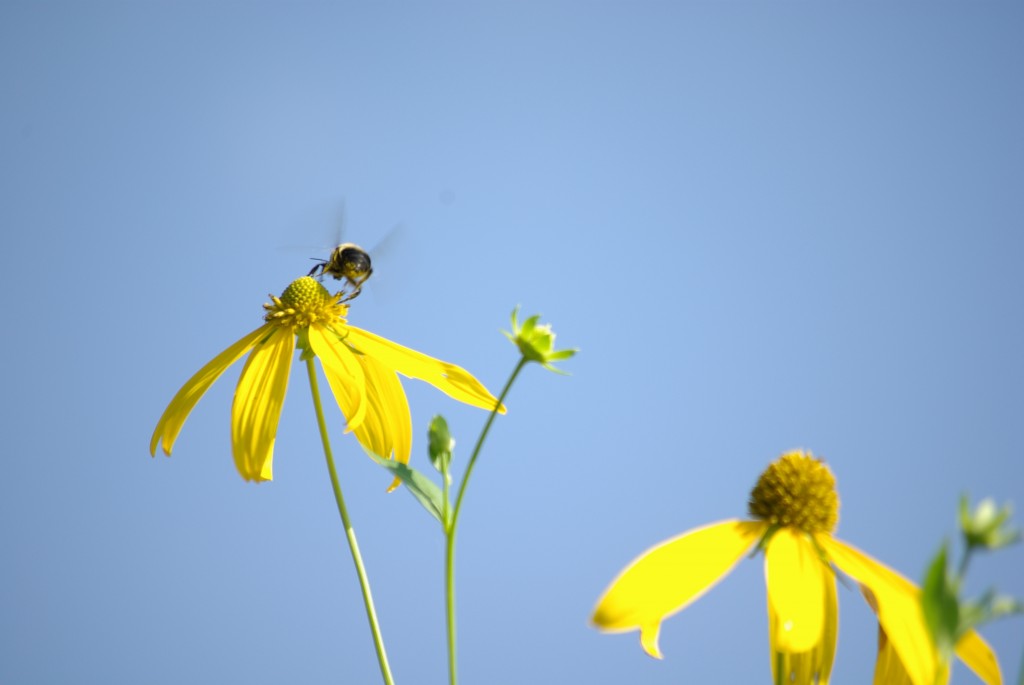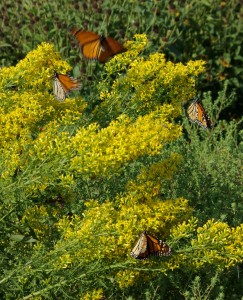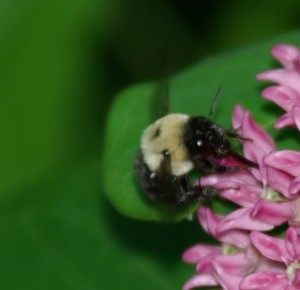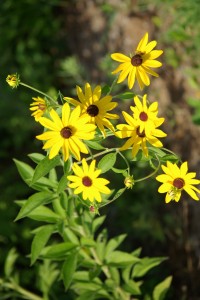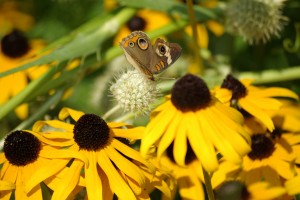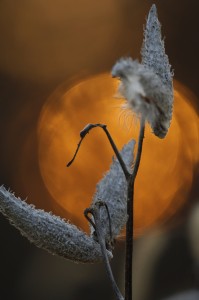Dog Day Flowers Paint Bluffs with Golden Hues
Early European settlers unpacked naming traditions along with all the cultural baggage they brought from their home countries. European naming echoes still in descriptions of August as the “dog days” of summer and the August moon as “dog days moon.” As apt as the thought of dogs panting through the hottest days of the year, “dog days” as the name for August actually derives from the star observations of antiquity and the rising of Sirius — the Dog Star — in heliacal aspect, at the same time as the Sun. Other cultures had their own naming traditions.
Local Amerindians, members of the clans and tribes of the Illini groups, used a lunar-based calendar, and thought of the August moon as the Yellow Moon. Native Americans, based in camps and villages usually located in the Bottoms, practiced subsistence farming and fished, trapped and gathered foodstuffs along the Mississippi River and its flood plain wetlands and forests. They routinely foraged and hunted game in the bluff lands. And the bluff scape, palely lighted by the August moon, glows yellow with the flowers of late summer.
Three genera of native plants festoon the bluffs with shades of yellow in August: goldenrods, sunflowers, and Rudbeckias, also called coneflowers. All are prairie plants, largely now relegated to our field and forest edges and roadsides. All three plant types had and continue to have an important role in both natural and human economies.
Members of the Solidago genus, goldenrods, the harbingers of autumn, are taken for granted, often overlooked as too common for consideration, sometimes seen as weeds and sometimes despised. Part of the disdain comes from the misperception — a complete falsehood — that goldenrod pollen causes common allergies, the “hay fevers” of sneezing, wheezing, and tearing eyes. Only plants that have wind borne pollen could cause such respiratory allergic reactions and goldenrod pollen simply is far too heavy to waft on the wind. The real culprit is ragweed, which blooms at the same time as goldenrods and often grows close by them. The two plant types differ in their pollination schemes: goldenrods attract insects as “hired hands” to transfer pollen in exchange for nectar currency; ragweeds, which have tiny greenish flowers, cast their fate and an enormous quantity of pollen into the air for wind sex.
Early European settlers and explorers discovered goldenrod in America and shipped it back home because they thought it beautiful, and, indeed, goldenrods became garden sensations. They still grace many European flower gardens, where, rather than accusations of making people sneeze, goldenrods are admired for their large swathes of late-summer columns of
golden blooms. The large colonies that goldenrods form are the result of another scheme for plant reproductive success. Like black walnut trees and some grasses, such as ryes, goldenrods are “allelopathic,” and exude toxic chemicals from their roots to discourage other plants from growing too close. As a result, they form large groupings, a sea of yellow, along our forest and field edges.
There are 14 species of goldenrod in the bluff lands of Monroe, St. Clair, and Randolph Counties. They come in various heights and varieties of leaf shapes and grow in diverse places, and extend their palate of yellow shades through late summer and early autumn, as their common names indicate. Early, late, Missouri, tall, field, rough, rigid, and showy goldenrods grow in our fields, prairies, forest edges and roadways. Woodland and elm-leafed goldenrods can be found deep in our shady woods. Gray goldenrod can be found only on our clifftop hill prairies. Buckley’s and petioled goldenrods are rarities occasionally found in our woodland forest glades.
Native Americans used goldenrod to make a yellow dye and as a medicinal for open wounds and burns. Early European settlers made a tea from the leaves of goldenrods and called it “Liberty Tea” during the American Revolution. The apparently refreshing tea was so well regarded that the dried leaves were shipped to China for many years after the war and so helped American businessmen establish an export trade with Asia.
Goldenrods remain the single most important plant for bees, both our native bee species and the European species of honeybees. Goldenrods provide a late-season nectaring source for bees stockpiling sugar sources for their over wintering larvae in the nest hives. It is a particularly crucial food source plant for our native bees, many of which do not live in colonies, but reside in solitary nests, each caring for their own offspring and next summer’s generation.
European honeybees first were introduced to the Jamestown, Virginia, colony in 1622. Though the colony itself failed, the European honeybee was successful and spread rapidly across North America. Thomas Jefferson noted that Native Americans called honeybees “white man’s flies,” and, for tribes far to the west, the arrival of honeybees often announced the impending arrival of white settlers. Today, honeybees are beset with numerous problems, suffering from mites and virus-induced diseases. Their decline and possible loss will have serious impacts, for over 100 crop plants, most of our garden vegetables and all of our orchard fruits require insect pollination, most of which has been provided by honeybees. Agro-science now is working overtime to study and perhaps bolster the numbers and health of our native bees — more than 4000 different species — and the additional native pollinators, flies, butterflies, moths and beetles, in hopes that they can take over the honeybees’ task. The
economic value of insect-pollinated crops in the U.S. in 2005 was $40 billion and one-quarter of all we eat and drink needs insect pollination. Native bees — carpenters bees, leaf-cutting bees, mason bees, bumble bees, even sweat bees — gathering nectar from and transferring pollen between goldenrods through the heat of August may become the primary “hired hands” of our own food production.
Sunflowers also bring a wash of yellow color to the bluff lands in August. The genus Helianthus is native only to the New World and contains between 70 to 80 species. There are 11 species of sunflowers native to our area. Thin-leaved, woodland, small-woodland, and pale-leaved sunflowers grow deep in bluff woodlands. Sawtooth and bristly sunflowers flourish along forest edges. Petioled and prairie sunflowers can be found at field edges and along sunny roadways.
Among the tallest and most robust of our native sunflowers is H. tuberosa, also known as Jerusalem artichoke, though it is not from the Middle East and isn’t an artichoke. The common name resulted from two mistakes. After seeing Native Americans eating the roots of this sunflower, French explorers tried some and thought the taste similar to an artichoke. Like many other plants, these were exported to Europe as a food crop. Italian growers named them girasole, meaning “turns to the sun.” Imported then to England, girasole was mispronounced as Jerusalem. Up to seven feet tall, the plants have reddish stems and long, hairy leaves, with four-inch wide flowers sitting on individual stalks at the tops of the stems. Large colonies spread by both seed and root offsets, and, once taken into a garden bed, can become invasive. And, as Native Americans, French explorers, Italian growers and English greengrocers found, the tubers are edible, and may be eaten raw, cooked in stews, roasted or sautéed with other vegetables. A brief Google search yields recipes as diverse as “Jerusalem artichoke soup with white truffles,” and “Roast chicken with Jerusalem artichokes and Parmesan.”
Another food crop, though one without such exotic recipes, comes from H. annuus, the common or garden sunflower. Widely occurring in and around our open fields, common sunflowers are native to the Western U.S. and were brought into our region by Native Americans who traded across the continent with other Amerindians. Local Native Americans grew common sunflowers and used the roots and leaves to make a medicinal tea. They used the seeds for both eating and to produce oil for a hair dressing. Today, cultivars of common sunflower are grown commercially, both for a food crop for humans and birds and for the useful seed oil, with three and one-half million acres under cultivation in the U.S. in 2005.
While both sunflowers and goldenrods stand tall to display their blossoms,
Rudbeckia, our third most prominent flower in August, provides shorter, dark-centered blooms to color the bluff landscape. Also known as coneflowers, and, sometimes as “the Susies,” or “the Beckies,” Rudbeckias add yellow tints from early summer up to the time of frosts. Four species are native to Monroe and Randolph Counties.
Goldenglow (R. laciniata), are a rarity here, growing along forest edges and shaded roadways on moist ground. Brown-eyed Susans (R. triloba) are scattered throughout the woodlands. Missouri coneflower (R. missouriensis), which grow only in our area in all of Illinois, can be found in hill prairies and forest glades.
Our most common Rudbeckia is the familiar Black-eyed Susan (R. hirta), which
grow, seemingly, everywhere: fields and edges, roadways and ditches, treelines and fencelines. Favored by gardeners, Black-eyed Susans have been transformed by plant hybridizers into the huge-flowered annual forms known as Gloriosa Daisy. The common name apparently was given to the plant as a result of a popular 18th century American ballad, in which a black-eyed Susan boarded a ship to bid farewell to her sweet William, also the common name of our native woodland phlox.
Rather than romantic ballads, early farmers in the Eastern U.S. offered curses to this prairie plant which invaded their fields, and which, they mistakenly felt, poisoned their livestock. The plants, with their innate ability to establish themselves in disturbed grounds, found easy pathways to naturalization all the way from the Midwest to the Atlantic coast as the great Eastern forests were cut down and transformed by agricultural cultivation. But, where farmers saw weeds, gardeners saw beauty. Black-eyed Susans won the popularity vote and, though not native to the state, became the state flower of Maryland in 1918.
From state flowers to gourmet cooking to prime food source for bees, the flowers that color our bluffs in August — the dog days — paint the days within the
month of the Yellow Moon with a cheering golden hue.
Clifftop, a local nonprofit organization, is focused on preserving and protecting area bluff lands.
A version of this article appeared in the August 1 2007 edition of the Monroe County Clarion.
© 2007 all content rights reserved, Clifftop NFP.
Comments are currently closed.

